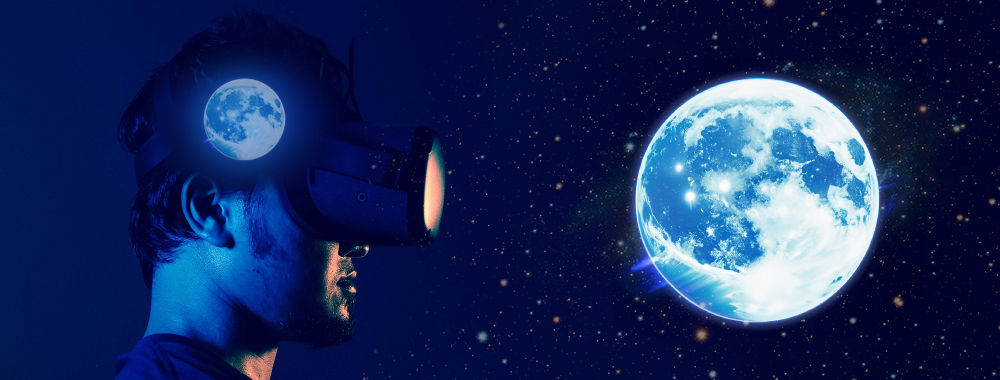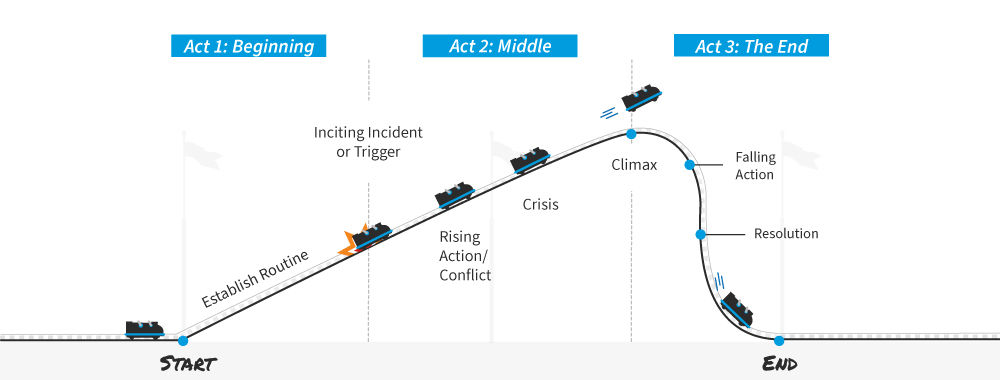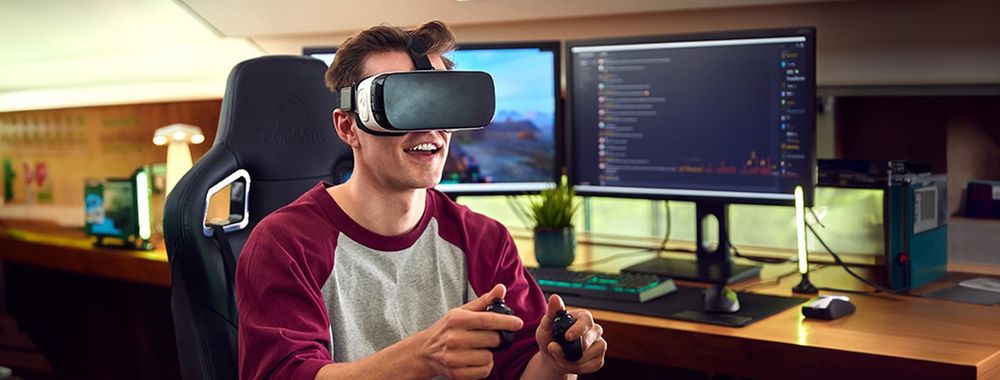The Past, Present, and Future of Virtual Reality

- 598 shares
- 2 mths ago
Presence refers to the subjective feeling of “being there” in a virtual environment as if a user is truly present within it. It encompasses the psychological and emotional connection users establish with the virtual environment.
Presence is both a psychological state and a subjective perspective because a user’s personal experience informs how they experience the virtual world. Their feelings are created and/or filtered by the virtual world and connected technology.
Presence is vital in virtual reality (VR) because it fundamentally defines the quality of the user's experience. A heightened sense of presence leads to increased user engagement, emotional involvement, and a stronger connection with the VR environment.
This video contains an exercise that will encourage you to think of ways to induce immersion in a VR experience.
Presence is closely associated with VR rather than augmented reality (AR). AR overlays digital information onto the real world to enhance actual surroundings. While AR can provide a sense of integration between the digital and physical realms, presence doesn’t apply in the same way in AR as it does in VR. Nonetheless, AR can offer a form of presence when digital elements seamlessly merge with the real world, providing an engaging mixed-reality experience with distinctions from typical VR experiences.
Presence and immersion are related concepts in virtual reality (VR), but they have distinct characteristics.
Presence is about the user's perception and mental state and focuses on how effectively the virtual environment can make them forget the real world. It relies on the user's feeling of "being there," even though they are fully aware of the virtual environment's objects, events, and characters, and sometimes disregard the technology itself. On the other hand, immersion is primarily about the technology (the VR headset for example) and how effectively it can engage the user's senses to create a convincing virtual environment.
A high level of presence means that users truly feel like they are in the virtual world, and they might not be as concerned about the quality of the technology, as long as the illusion remains intact. A high level of immersion contributes to the creation of a convincing virtual environment, making it easier for users to suspend disbelief.
Presence is influenced by immersion. A highly immersive VR system is more likely to induce a sense of presence. Both immersion and presence aim to make the user's experience in VR as engaging and realistic as possible. Ultimately, both concepts are centered around the user's experience and perception of a virtual environment.
To create immersive and presence-inducing VR experiences, you should pay close attention to various design elements.
© Interaction Design Foundation, CC BY-SA 4.0
Visual realism, spatial audio, interactivity and agency, or a sense of control over the virtual experience contribute to the feeling of presence. It’s also essential that a comfort and safety is prioritized—cybersickness or discomfort can make or break the sense of presence. The optimal field of view musn’t be forgotten in connection with comfort.
Illusions of presence in VR refer to the perceptual tricks and psychological states that make users feel as if they are actually present in a virtual environment, even though they are aware that it is a digital simulation. These illusions are a result of technology-driven immersion and encompass:
Users feel like they are in a physical environment within the virtual world. This illusion is created when sensory input from the VR experience aligns with real-world experiences. A stable sense of place is crucial to maintain a sense of presence.
As a designer, you must ensure that the VR environment is spatially consistent. Visual and auditory cues should match users' real-world experiences. This means objects and sounds should behave as they would in the physical world, which provides users with a stable sense of place. For instance, if you’re in a forest, you would hear the crunch of leaves and earth underfoot. Sounds of birds chirping, insects buzzing would surround you and possibly a steam bubbling in the distance.
This illusion involves the perception that the user has a body within the virtual world. Even when users are disembodied (lacking a visible virtual body), they can still experience a strong sense of presence. When a user's virtual body matches their movements and physical sensations (e.g., feeling something in the virtual world touch their skin), presence is enhanced.
Whenever possible, provide users with a virtual body or avatar within the VR environment. The virtual body should ideally match users' real-world movements. This contributes to the perception that they have a presence within the virtual space. For example, in a VR game, you should see your own virtual hands as you move your real hands. When you raise your real hand, your virtual hand in the game also rises, and when you wave, your virtual hand waves too. This kind of self-embodiment makes you feel like you're inside the game as if your virtual hands are your own.
Interaction with the virtual environment is vital for presence. When users can see, hear, or feel the consequences of their actions in the virtual world, it enhances their sense of presence. This illusion can be achieved through various feedback mechanisms, such as haptic feedback, audio cues, or visual responses.
Design interactions that provide feedback to users. When users take actions in the virtual world, they should experience corresponding sensory feedback. Imagine you're in a VR cooking game. You reach out to grab a virtual egg with a controller, and as you do, you not only see the virtual egg in your hand but also feel a slight vibration in the controller, simulating the sensation of holding an egg. When you crack the egg on the virtual frying pan, you hear the sound of the eggshell cracking and feel a small haptic jolt in the controller, mimicking the impact.
Social presence involves feeling as if one is genuinely interacting with virtual characters or other users within the VR environment. The realism of these interactions, whether through verbal communication or body language, contributes to the sense of social presence. Even relatively low-fidelity representations can evoke a strong social presence, and it's a key aspect of many VR applications, such as multiplayer games or virtual meetings.
In applications where social interaction is key (also known as social VR), create realistic interactions between users and virtual characters or other users. Realistic communication through voice, gestures, and body language enhances social presence. For instance, In a multiplayer VR game set in a bustling virtual city, your avatars replicate your real-life gestures and actions. When you share a laugh with your friend or exchange a virtual high-five, your avatars respond in kind. Even when you greet another player with a wave, your avatars reflect your actions, creating a strong sense of social interaction and presence in the urban virtual environment.
Learn how to design a strong sense of presence in VR with our course: UX Design for Virtual Reality.
Read up on “What is Virtual Reality (VR)” in this piece.
Read Jason Jerald’s comprehensive book on VR, which talks about the concept of presence in-depth, The VR Book: Human-Centered Design for Virtual Reality.
Cornel Hillmann’s book UX for XR: User Experience Design and Strategies for Immersive Technologies, provides an in-depth examination of UX design for VR and beyond.
Get a deeper understanding of Immersion in this piece.
Read about why presence is important in VR in this blog article, “What Is ‘Presence’ in VR, and Why Is it So Important?”.
To measure presence in a virtual reality (VR) experience, VR researchers, including Mel Slater, employ a combination of subjective and objective methods. Subjectively, questionnaires and scales, such as the Presence Questionnaire (PQ) and the Slater-Usoh-Steed (SUS) questionnaire, are widely used. These tools assess the user's sense of being in the virtual environment, the extent to which the virtual environment becomes the dominant reality, and the level of engagement with the environment.
Objective measures include physiological responses (heart rate, skin conductance) and behavioral indicators (movement patterns, interaction rates within VR). These metrics offer insights into the user's immersion and physiological arousal, which are indicative of presence.
Mel Slater's research emphasizes the importance of "place illusion" and "plausibility illusion" in establishing presence. Place illusion refers to the sensation of being physically located in the virtual environment, while plausibility illusion relates to the extent to which the environment behaves in a believable manner in response to the user's actions. Achieving these illusions is crucial for a strong sense of presence.
Slater also highlights the role of immersive technologies in enhancing presence, such as high-quality graphics, accurate motion tracking, and auditory cues that align with visual stimuli. By combining subjective assessments with objective data and focusing on the critical elements of place and plausibility illusion, researchers can effectively measure and understand presence in VR experiences.
Learn more about presence in the Master Class, How To Influence Behavior Through Virtual Reality Narratives, by Mel Slater.
Several factors contribute to a strong sense of presence in virtual reality (VR), creating a convincing and immersive experience for users:
High-quality graphics: Realistic visuals make the virtual environment appear more believable and engaging.
Accurate motion tracking: Precise tracking of user movements ensures that interactions with the virtual environment are seamless and intuitive, reinforcing the feeling of being in the virtual space.
Effective audio cues: Spatial audio that matches the visual environment enhances realism, which helps users feel more connected to the virtual world.
Responsive interaction: The environment's ability to react in real-time to user actions contributes significantly to the sense of presence.
Haptic feedback: Tactile feedback through controllers or haptic suits increases the realism of interactions.
Narrative engagement: A compelling storyline or scenario that draws users into the experience can significantly enhance the sense of presence.
These factors, when effectively combined, create a powerful sense of presence in VR.
Learn more about presence in our course, UX Design for Virtual Reality.
Slater, M. (2009). Place illusion and plausibility can lead to realistic behavior in immersive virtual environments. Philosophical Transactions of the Royal Society B: Biological Sciences, 364(1535), 3549–3557. https://doi.org/10.1098/rstb.2009.0138
Slater, M. (1999). Measuring presence: A response to the Witmer and Singer presence questionnaire. Presence: Teleoperators and Virtual Environments, 8(5), 560–565. https://doi.org/10.1162/105474699566477
Witmer, B. G., & Singer, M. J. (1998). Measuring presence in virtual environments: A presence questionnaire. Presence: Teleoperators and Virtual Environments, 7(3), 225–240. https://doi.org/10.1162/105474698565686
Yuan, Y., & Steed, A. (2010). Is the rubber hand illusion induced by immersive virtual reality? In 2010 IEEE Virtual Reality Conference (VR) (pp. 95–102). https://doi.org/10.1109/VR.2010.5444807
Skarbez, R., Brooks, F. P., Jr., & Whitton, M. C. (2017). A survey of presence and related concepts. ACM Computing Surveys, 50(6), Article 1-39. https://doi.org/10.1145/3134301
Slater, M., Spanlang, B., & Corominas, D. (2010). Simulating virtual environments within virtual environments as the basis for a psychophysics of presence. ACM Transactions on Graphics, 29(4), Article 1-9. https://doi.org/10.1145/1778765.1778829
Stoffregen, T. A., Bardy, B. G., Smart, L. J., & Pagulayan, R. J. (2003). Presence and user experience in a virtual environment under different levels of realism. Nature, 466, 1077–1079. https://doi.org/10.1038/nature0912
Jung, S., & Lindeman, R. W. (2021). Perspective: Does realism improve presence in VR? Frontiers in Virtual Reality, 2, Article 27. https://doi.org/10.3389/frvir.2021.693327
The design of VR content has a major effect on the sense of presence. The design influences how immersive and believable the virtual environment feels. Effective design incorporates realistic graphics, accurate motion tracking, and spatial audio, all of which enhance the user's sense of being in the virtual world. Interactive elements that respond logically to user actions further increase presence, as they provide users with a sense of control and influence within the environment. Additionally, a narrative that engages users emotionally and cognitively can deepen the sense of presence, making the virtual experience more compelling and memorable.
Learn more about presence in the Master Class, How To Influence Behavior Through Virtual Reality Narratives, by Mel Slater.
Interactivity plays a crucial role in creating a sense of presence in VR. It enables users to interact with the virtual environment in a meaningful way. It fosters a sense of control and agency, which allows users to influence the virtual world through their actions. This engagement makes the experience more immersive, as users feel directly connected to the virtual environment. The more responsive and intuitive the interaction mechanisms are, the stronger the sense of presence, as users perceive their actions as having a real impact within the virtual space. Thus, interactivity is key to bridging the gap between the user and the virtual world, enhancing the overall sense of being truly 'present' in a VR experience.
Learn more about presence in the Master Class, How To Influence Behavior Through Virtual Reality Narratives, by Mel Slater.
Different sensory feedback mechanisms contribute significantly to presence in VR by enhancing the immersive experience. Visual feedback provides a realistic depiction of the virtual environment, making it visually compelling and believable. Auditory feedback, through spatial sound, enhances the realism by mimicking how sounds occur in the real world, further immersing the user. Haptic feedback adds a tactile dimension, allowing users to 'feel' virtual objects and interactions, which greatly increases the sense of being physically present in the virtual space.
Learn more about presence in the Master Class, How To Influence Behavior Through Virtual Reality Narratives, by Mel Slater.
Jerald, J. (2015). The VR Book: Human-Centered Design for Virtual Reality (Illustrated ed.). Association for Computing Machinery.
Hillmann, C. (2021). UX for XR: User Experience Design and Strategies for Immersive Technologies (1st ed.). Apress.
Presence in virtual reality (VR) significantly influences users' cognitive and emotional states. It heightens emotional engagement, making experiences within VR more impactful and memorable. Users tend to have stronger emotional responses to VR scenarios than to other media due to VR's immersive qualities.
Moreover, presence improves learning and information retention, as the immersive "being there" feeling enhances the absorption and recall of presented content. This makes VR a potent tool for education and training.
Presence also alters users' perception and behavior, affecting spatial awareness and potentially influencing real-world actions. It can increase empathy by allowing users to experience situations from diverse perspectives, deepening their understanding of different viewpoints.
However, the intense experience of presence might cause disorientation or cybersickness in some users and can lead to psychological discomfort if not carefully managed.
Learn more about presence in the Master Class, How To Influence Behavior Through Virtual Reality Narratives, by Mel Slater.
Remember, the more you learn about design, the more you make yourself valuable.
Improve your UX / UI Design skills and grow your career! Join IxDF now!
You earned your gift with a perfect score! Let us send it to you.
We've emailed your gift to name@email.com.
Improve your UX / UI Design skills and grow your career! Join IxDF now!
Here's the entire UX literature on Presence in Virtual Reality (VR) by the Interaction Design Foundation, collated in one place:
Take a deep dive into Presence in Virtual Reality (VR) with our course UX Design for Virtual Reality .
Master complex skills effortlessly with proven best practices and toolkits directly from the world's top design experts. Meet your experts for this course:
Frank Spillers: Service Designer and Founder and CEO of Experience Dynamics.
Mel Slater: Distinguished Investigator at the University of Barcelona in the Department of Clinical Psychology, active member of the Institute of Neurosciences, and Co-Director of Event Lab (Experimental Virtual Environments for Neuroscience and Technology).



We believe in Open Access and the democratization of knowledge. Unfortunately, world-class educational materials such as this page are normally hidden behind paywalls or in expensive textbooks.
If you want this to change, , link to us, or join us to help us democratize design knowledge!
